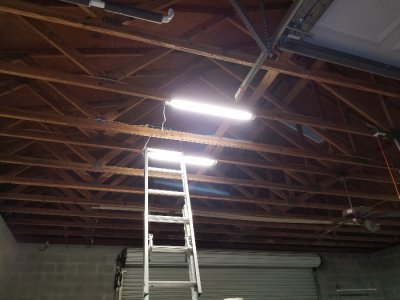- Joined
- Jun 15, 2017
- Messages
- 531
Has anyone here noticed how quickly lighting is changing?
When I moved to this house in '17, it already had LED-only tube fixtures in the shop. No ballasts. For that year, that was impressive.
Recently, I got tired of the oppressive glare of the tubes. They were not frosted, so I had a bunch of tiny LED's staring right at me through clear plastic. I decided to look for frosted tubes.
It turned out the frosted tubes put out less light. While I was looking around, I found a bunch of integrated-LED fixtures. These things have LED's built right into them. The down side is that you can't change the light sources when they go bad. You have to buy new fixtures. But they put out a ton of light, they come in convenient shapes, they don't cost a lot, and you can get fixtures with diffusers built in so the glare is reduced.
My shop had two two-tube 4' fixtures which were poorly located and poorly oriented. Today I bought two $17 LED fixtures, put them up in better locations, aligned them so they would distribute light better, and tore down an old tube fixture. I ended up with much better light in the shop, and when I'm done replacing the other fixture, I'll have 4 old LED tubes I can use to replace the failing fluorescents in my storage room. That room has home-grade fixtures with lenses, so it doesn't need frosted tubes.
LED Fixtures I Bought
Instead of 4000 lumens times two in the shop, I will have 6000 times two.
The wiring is kind of sloppy because the builder never foresaw the kind of fixtures I bought, but it's an outbuilding, so it doesn't matter if there is a little bit of visible electrical tape on top of the trusses.
I ordered 16' of LED strip lighting, and I plan to use it under some shelves that get very little light now. I'm also going to put LED lights under one of my tool chest lids. It has a power strip inside the top, so I can plug the LED's in and forget about batteries.
When I moved to this house in '17, it already had LED-only tube fixtures in the shop. No ballasts. For that year, that was impressive.
Recently, I got tired of the oppressive glare of the tubes. They were not frosted, so I had a bunch of tiny LED's staring right at me through clear plastic. I decided to look for frosted tubes.
It turned out the frosted tubes put out less light. While I was looking around, I found a bunch of integrated-LED fixtures. These things have LED's built right into them. The down side is that you can't change the light sources when they go bad. You have to buy new fixtures. But they put out a ton of light, they come in convenient shapes, they don't cost a lot, and you can get fixtures with diffusers built in so the glare is reduced.
My shop had two two-tube 4' fixtures which were poorly located and poorly oriented. Today I bought two $17 LED fixtures, put them up in better locations, aligned them so they would distribute light better, and tore down an old tube fixture. I ended up with much better light in the shop, and when I'm done replacing the other fixture, I'll have 4 old LED tubes I can use to replace the failing fluorescents in my storage room. That room has home-grade fixtures with lenses, so it doesn't need frosted tubes.
LED Fixtures I Bought
Instead of 4000 lumens times two in the shop, I will have 6000 times two.
The wiring is kind of sloppy because the builder never foresaw the kind of fixtures I bought, but it's an outbuilding, so it doesn't matter if there is a little bit of visible electrical tape on top of the trusses.
I ordered 16' of LED strip lighting, and I plan to use it under some shelves that get very little light now. I'm also going to put LED lights under one of my tool chest lids. It has a power strip inside the top, so I can plug the LED's in and forget about batteries.
Attachments
Last edited:


